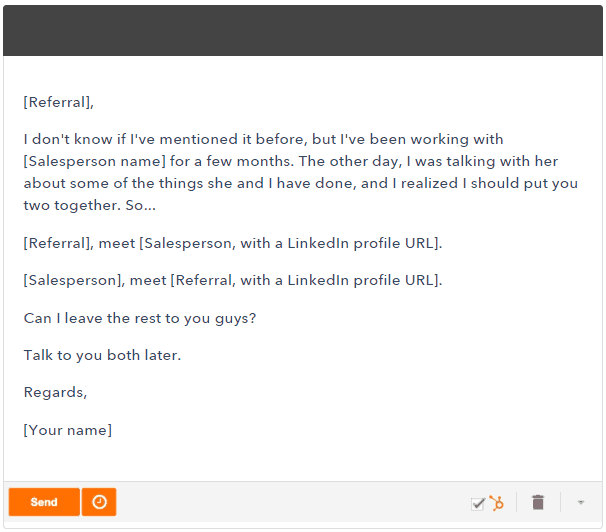I’ve specialised in lead generation for 25 years now. Sometimes as a front line account manager. Sometimes as a business owner.
And, you know, I hate cold calling.
Love talking to people about their challenges and helping them solve business problems.
Hate cold calling.
So, I’ve made it my business, literally, to learn how to generate leads without cold calling, and this is what I found out.
Maybe you dislike cold calling as well? If so here’s my all out guide to B2B lead generation without cold calling.
- What is a Cold Call?
- Cold Calling works, just not that well
- Warm Calls Convert Leads at Higher Rates
- Alternatives to Cold Calling that Work
- Generating Leads from Referrals
- Getting Leads via Public Speaking
- Lead Generation via Inbound Marketing / Content Marketing
- Answering Questions on quora, LinkedIn Groups, etc
What is a Cold Call?
So let’s start with a quick definition:
Cold calling is a lead generation tactic where you pick names from a list (telephone book, bought list, LinkedIn profile, etc) and call people, when they have no knowledge of you or your business, with the intent of converting them into a prospect, and finally a customer.
Personally, I’d say, even if you’ve done some research on the person and their company, a call like this is a cold call.
Conversely, a warm call is calling a person who knows of you and/or your business. That knowledge might come from a mutual introduction, meeting you at an event, visiting your website, etc.
Cold Calling works, just not that well
Here are a few statistics that show just how low yield cold calling is:
- HubSpot found that less than 2% of cold calls actually result in a meeting
- Biznology found that less than 1% of cold calls lead to a sale
Kind of depressing.
Of course cold calling does work because it is still used by a range of industries but it has:
- Very low conversion rates – this translates into high costs
- High sales burnout rates – with a high rate of rejection, it takes a tough soul to continue to cold call for long periods of time
Warm Calls Convert Leads at Higher Rates
Not only are warm calls easier on the rejection psyche, but they also covert at much higher level. This is mostly because you start the relationship with some level of trust from the person you are calling.
Trust is worth a lot in the sales cycle.
Most importantly, trust provides that vital few minutes at the very beginning of a relationship where you get a chance to introduce yourself and possibly learn more about your prospects problem.
Alternatives to Cold Calling that Work
There are are lots of alternatives that you can use to generate leads without cold calling.
I’ve tried most of them over the years and here’s my take on what works.
By the way, I’m not including in this list things like advertising, trade shows and other “external” mediums. They are covered in this large post on B2B Marketing. Here I’m really focused on alternatives to cold calling that the sales team can implement directly.
Generating Leads from Referrals
You see this a lot in “how to use LinkedIn” style blog posts and courses: find a mutual connection and ask them to introduce you. Simple.
This works well and allows you to transfer some of that vital, warm lead trust, from the Introducer to yourself.
There are lots of approaches you can use:
- LinkedIn – although I don’t think this works as well as it did in the past. People don’t control their networks as tightly as they once did so, they may not, in fact, know you or the prospect.
- Customers – they already know you and your business so their introduction has weight.
- Business colleagues – also a good approach
- Networking organisations – Chambers of commerce, business networking groups, etc.
Problems
The biggest problem with trusted introductions is they doesn’t scale very well. After you’ve asked all of your contacts, the opportunities thin out. However, they are worth it if you are in a new market.
This can also work if you only need a small, steady stream of clients. I’ve seen it work well for small consulting partnerships.
Getting Started
Start by listing the contacts you’d feel comfortable asking for a referral.
Then … ask them … but make it easy by doing two things:
1. Be as specific as possible on who you can best help as a business.
Don’t say:
Do you know anyone to whom you can refer me?
Do say:
We work best with COOs of $3-$20 million revenue B2B businesses that are looking to improve their lead generation. Do you know anyone that fits that mold?
After all, if you can’t be clear on your target prospects, then how can you expect your trusted referreral to know?
2. Give them a script they can follow.
We’re all busy, so make it even easier by providing a simple script they can follow when they make the introduction.
For example, HubSpot have a nice referral letter template:

This reduces the friction and, again, makes it easier to assist you.
Getting Leads via Public Speaking
Presenting at conferences and events is a well trodden approach to B2B lead generation.
The basic idea goes like this:
- Find events where your target prospects meet.
- Approach the event organisers and ask to present as a subject matter expert.
- Prepare and execute a “knock your socks-off” presentation
- Prospects at the event contact you afterwards for a meeting.
These events can be on-line (webinars), conferences or even your local better business bureau weekly catch-up.
I’ve tried these in the past and they didn’t work that well for me. There are a few issues:
- It doesn’t scale very well – there is only one of you and there are only so many events at which you can speak.
- Long lead times – It can take a long time to get onto the list to speak. Organisers want good speakers for their events and can require proof of your abilities before putting you on the program. This creates a Catch 22 problem: you can ‘t present until you prove yourself but you can’t prove yourself until you present.
- Organisers often charge you to present – Organisers often charge speakers for the ability to present at their events because they also know it’s a way for companies to generate new leads. This dramatically drives up the cost per lead, and risk if you don’t generate leads.
- Leads may not appear – At the end of the process there is no guarantee that you will receive any leads.
- Time – Creating a “knock your socks-off” presentation takes time and effort, normally a lot of time and effort. The presentation has to be great – if you’re just so-so you’re less likely to generate those leads.
Still, if you can re-use the content and maybe turn it into a webinar this can be a useful part of the overall solution.
Getting Started
If you do decide to go down the speaking event approach make sure you are systematic about it.
In terms of overall effort, the speaking part is a minor task. To be really effective you need to pre-promote, and post promote the event to ensure you drag in those prospects.
This post has some good ideas on the things you need to cover: 9 Ways to Maximize Your Lead Generation from Speaking Engagements
Lead Generation via Inbound Marketing / Content Marketing
Inbound Marketing and Content Marketing are just different terms for the same thing. Whatever you call it – it’s my favourite approach.
Here is full description of how to run your Content Marketing process but in summary you:
- Produce and share your very best ideas.
- Google gets to know you’re a great source of information in your niche and sends people to your site.
- They like what they see and call you for help.
Inbound leads are great because you don’t need to manufacture a reason to talk to them. You have a ready made reason: “What did you think of the content your saw/downloaded.”
Other great attributes of inbound leads include:
- they tend to progress through the sales process more quickly than cold calling leads
- Their initial trust in you is higher, as your expertise has been demonstration by the content.
In practice there are of course a few bumps in the content marketing road.
Fear of giving away your high value IP
For consultancies and businesses that rely on their ideas to make money there is a real fear that by sharing that IP they’ll lose customers.
This turns out not to be true because:
- Prospects that want to learn about your “stuff”, so they can do it themselves, are never going to hire you. So nothing lost.
- Prospects that discovered the problem was tougher to solve than expected, are going to hire you to do the task anyway.
- The people that think they can probably do what you do, but do don’t have time do it or don’t want to risk messing it up, are still going to hire you.
So, in reality, it’s all upside and your risk of loss is low.
Getting Google to notice you is tough
Yep, no doubt about it, thousands, probably millions, of words have been written on how to get to the top of the Google rankings. But, while there is some skill involved, it’s by no means impossible.
With a good content marketing agency and the investment of some time it is possible for even small organisations to show Google they have the very best content.
Long Lead Times
If you want 100 leads tomorrow, content marketing is not a good fit.
It can take weeks and sometimes months to build out the process before it starts to generate substantial returns.
Content Marketing scales very effectively
However, once you have the content in place it will scale almost infinitely. It basically costs the same to deliver your content to the 10,000th person as it does to the first.
Plus it works night and day to educate prospects on what you can do and how you can help them.
The impact of Social Media
82% of buyers believe a company is more trustworthy if it’s active in social media, according to a BrandFog study
So the general advice goes that you should be moderately active in the social media platform where your prospects congregate. LinkedIn is generally regarded at the most important B2B social media platform.
If, when your prospect comes across your content they are already familiar with you and/or your company from social media posts, it will work in your favour.
Best Practices
Of course it’s no good just writing great content, you also have to encourage people to contact you. This is generally called lead capture and there are lots of tools out there for this task.
You will also want to automate the lead nurturing process in such a way that you only contact inbound leads when they have demonstrated their interest.
Getting Started
We have an entire section on getting going in Content Marketing – start here for a great introduction.
Answering Questions on quora, LinkedIn Groups, etc
The idea here is that you become known in a particular area by publicly answering question on social platforms. Prospects then get to know you and either reach out directly or present you with the opportunity to connect with them.
quora and LinkedIn Groups are the elephants in this market and I’ve benefited from both.
LinkedIn Groups
These have been “rebooted” a few times by LinkedIn. At one point they were a pretty good way to build a reputation and connect with prospects. I’m just not sure that’s the case anymore.
LinkedIn Groups that are truly conversations between people who want to learn, share best practices and help people in your industry are few and far between these days. They seem to have mostly devolved into link dropping opportunities for companies to spruik their latest offer or blog posts.
This is not universally true of course. Some group moderators do a good job. However, a while ago (2017) I reviewed all of my groups by looking at the post / reply ratio. With few exceptions there was little interaction and little point in jumping in.
quora
quora seems to be doing a slightly better job at the question and answer format.
One thing that annoys me about the platform is the inability to set up searches that automatically alert you when a relevant question is asked or answered. Rather you seem to have to go back time and again to search for questions that you might be able to answer.
Getting Started
These approaches can both work well but you have to be in them for the long run to be successful. Bouncing in and out is not going to be effective.
You also need to consider that if you’re providing content on these platforms, the platform will be able to use it in very broad terms. Make sure you are comfortable with that first.
If you want to try this approach, check out this post on how to use resources from LinkedIn groups.




